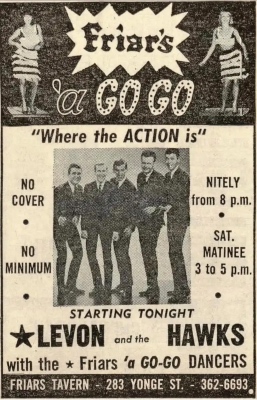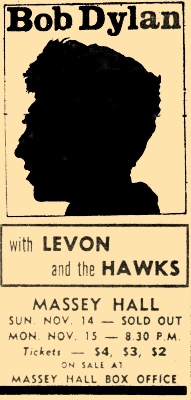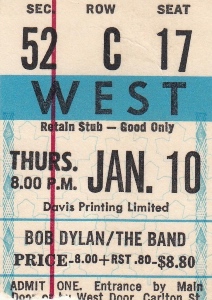Music journalism, books and more
Bob Dylan and the Hawks
Today is the 60th anniversary of Bob Dylan plugging in his guitar at the Newport Folk Festival, an event blown up into the book Dylan Goes Electric! The Night That Split the Sixties which, in turn, inspired the recent film A Complete Unknown. While much is made of Dylan’s now mythical July 25, 1965 appearance with the Paul Butterfield Blues Band, the pairing pales in comparison with the huge role that Toronto’s Levon & the Hawks (later The Band) played in transforming the folk icon into a rock trailblazer.
 It began quietly one night that September when Dylan flew up to Toronto to check out a super-tight rock group at Friar’s Tavern recommended to him by Mary Martin, a Toronto woman then working for his manager Albert Grossman. Dylan jammed with them there at 283 Yonge Street until the wee hours. So impressed was he with their sound that he immediately hired Levon & the Hawks to become his backing band. After playing 18 dates in the U.S. together that fall, Dylan brought the group back to their hometown for two nights in November at Massey Hall.
It began quietly one night that September when Dylan flew up to Toronto to check out a super-tight rock group at Friar’s Tavern recommended to him by Mary Martin, a Toronto woman then working for his manager Albert Grossman. Dylan jammed with them there at 283 Yonge Street until the wee hours. So impressed was he with their sound that he immediately hired Levon & the Hawks to become his backing band. After playing 18 dates in the U.S. together that fall, Dylan brought the group back to their hometown for two nights in November at Massey Hall.
For the first set each night, Dylan performed solo on acoustic guitar, seemingly to appease his diehard folk fans. But when he came back out for the second sets, with Robbie Robertson, Rick Danko, Richard Manuel, Garth Hudson and Levon Helm, the reaction was as mixed at it was at Newport. Many cheered the homecoming of their local heroes and the raw, electrified renditions of songs like “It Ain’t Me, Babe” and “Like a Rolling Stone.” But others were mystified and left the hall scratching their heads. The Toronto Star reporter assigned to cover the show even sniffed in print following the concerts that Dylan’s appearances had been marred by the presence of a “third-rate Toronto bar band.”
Clearly, the Star reporter was out of touch—and way out of his depth. Levon & the Hawks were at the very zenith of the Toronto scene at the time, playing a brilliant blend of roots music, incorporating elements of blues, rockabilly, country and r&b, and inspiring other bands with their sound and style. “The best way I can describe the Toronto Sound is that it came from watching the Hawks, Robbie and the others,” Luke Gibson, of Luke & the Apostles, once told me. “It was based on Robbie’s Telecaster and Garth’s organ sound. They set the bar really high and we were like students, soaking it all up.”
 Dylan’s partnership with the Hawks got off to a precarious start, with audiences booing and Helm dropping out of the tour from frustration. In the beginning, Robertson told music historian Robert Palmer, “there was a lot of skepticism (among the Hawks) about whether this was meant to be. There was a lot of strumming going on in [Dylan’s] music, and we didn’t play with strummers. Anybody who strummed, it just seemed to take the funkiness out of it. Unless, of course, it was rockabilly, and this wasn’t rockabilly.” But, added Robertson, “Bob was in the process of opening up a door, and music needed this door opened. It was like the beginning of rock ’n’ roll in a way—mixing two worlds together.”
Dylan’s partnership with the Hawks got off to a precarious start, with audiences booing and Helm dropping out of the tour from frustration. In the beginning, Robertson told music historian Robert Palmer, “there was a lot of skepticism (among the Hawks) about whether this was meant to be. There was a lot of strumming going on in [Dylan’s] music, and we didn’t play with strummers. Anybody who strummed, it just seemed to take the funkiness out of it. Unless, of course, it was rockabilly, and this wasn’t rockabilly.” But, added Robertson, “Bob was in the process of opening up a door, and music needed this door opened. It was like the beginning of rock ’n’ roll in a way—mixing two worlds together.”
It soon paid off. Dylan wound up performing with the Hawks through to December, 1965 and then resumed in February ’66 with more U.S. dates before heading overseas to Australia and Europe. During a show at the Free Trade Hall in Manchester, after “Ballad of a Thin Man,” with Danko’s haunting bass line dominating the song, someone in the audience yelled, “Judas!” Dylan snapped: “I don’t believe you! You’re a liar.” Then he turned to the Hawks and said, “Play fucking loud!” The band promptly kicked into a blistering “Like a Rolling Stone.”
 The last show of the tour was on May 27, 1966 at the Royal Albert Hall, and after withdrawing from the public eye and relocating to Woodstock because of a motorcycle accident he suffered on July 29 of the same year, it would be his last show on a major tour until 1974.
The last show of the tour was on May 27, 1966 at the Royal Albert Hall, and after withdrawing from the public eye and relocating to Woodstock because of a motorcycle accident he suffered on July 29 of the same year, it would be his last show on a major tour until 1974.
His backing group for his monumental comeback tour that year, which stopped at Toronto's Maple Leaf Gardens on Jan. 9 and 10, was The Band—the same five musicians, then known as Levon & the Hawks, that he first jammed with that September night in ’65. Critics have since hailed Dylan’s lyrical genius and The Band’s instrumental brilliance as a game-changing alchemy within popular music. No wonder Time magazine declared their first meeting at Friar’s Tavern as “the most decisive moment in rock history.”


